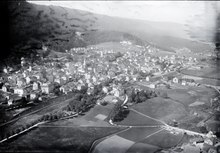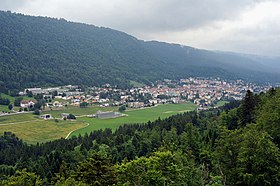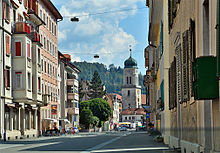Saint-Imier
| Saint-Imier (German Saint Always) |
|
|---|---|
| State : |
|
| Canton : |
|
| Administrative district : | Bernese Jura |
| BFS no. : | 0443 |
| Postal code : | 2610 |
| Coordinates : | 566736 / 222517 |
| Height : | 820 m above sea level M. |
| Height range : | 746–1491 m above sea level M. |
| Area : | 20.87 km² |
| Residents: | 5131 (December 31, 2018) |
| Population density : | 246 inhabitants per km² |
| Mayor : | Patrick Tanner (ARC) |
| Website: | www.saint-imier.ch |
|
Saint-Imier, from the Château d'Erguël |
|
| Location of the municipality | |
Saint-Imier is a municipality in the Bernese Jura administrative district in the Swiss canton of Bern . The German name Sankt Immer is mainly used in the wider region today.
geography
Saint-Imier is 820 m above sea level. M. , 15 km northeast of La Chaux-de-Fonds (linear distance). The industrial community extends in the central part of the Jura Valley Vallon de Saint-Imier , mostly on the left side of the Schüss (French Suze ), on the lower southern slope of Mont Soleil .
The area of the 20.9 km² municipal area comprises a section of the valley basin of the Vallon de Saint-Imier through which the Schüss flows. To the north, the area extends to Mont Soleil, which is 1289 m above sea level. M. forms the highest part of the anticlines of the Montagne du Droit , which accompanies the entire Vallon de Saint-Imier on its north side. The landscape of the Champ Meusel on the southern slope of Mont Soleil, northeast of Saint-Imier, was not created by erosion , but is the remnant of a meteorite impact in prehistoric times. It is the largest surviving evidence of a meteorite impact in Switzerland. In a narrow corner, the municipality extends further north into the valley of La Chaux d'Abel , which geographically belongs to the Franches-Montagnes (German Freiberge ). It shows the typical, slightly undulating plateau of the Plateaujura, on which boggy depressions, mostly without drainage above ground, alternate with limestone peaks . The community area extends to the south to the level of Les Pontins and to the south-east to the northern ridge of the Chasseral chain. Here is on the Cornette with 1490 m above sea level. M. the highest point of Saint-Imier. Extensive high pastures with the typical mighty spruce trees , which either stand individually or in groups, extend on the Jura ridges . In 1997, 9% of the municipal area was settled, 42% forest and woodland, 48% agriculture and a little less than 1% was unproductive land.
The settlement of Sur le Pont ( 780 m above sea level ) on the southern side of the Schüss and numerous individual farms, which are widely scattered on the Jura heights, belong to Saint-Imier . The neighboring municipalities of Saint-Imier are Sonvilier and Villeret in the canton of Bern, Muriaux , Le Noirmont and Les Bois in the canton of Jura and Val-de-Ruz in the canton of Neuchâtel .
history

The origin of Saint-Imier goes back to St. Himerius , a hermit who came from Lugnez in the Ajoie and who settled in the Schüsstal around 600. A chapel was built on his grave and a Benedictine monastery was founded. The settlement soon developed into a place of pilgrimage. The first written mention of the place dates back to the year 884 , when Emperor Karl III. the cella sancti Hymerii donated to the Moutier-Grandval monastery. Later, the names Sanctus Ymerius (962) and Sanctus Imerius (1239) appeared.
In 999, Saint-Imier was donated together with Moutier to the Bishop of Basel. The Saint-Imier monastery was transformed into a secular canon in the first half of the 12th century. It was subordinate to the diocese of Lausanne, but jurisdiction was exercised by the Prince-Bishop of Basel until the Reformation . In 1335 Saint-Imier closed a castle right with the city of Biel , which meant the beginning of Biel's influence on the Erguel rule in the Vallon de Saint-Imier. The Reformation was introduced by Biel in 1530 and the chapter was dissolved.
Saint-Imier was badly affected during the Thirty Years War . From 1797 to 1815 the municipality belonged to France and was initially part of the Mont-Terrible department , which was connected to the Haut-Rhin department in 1800 . Through the decision of the Congress of Vienna , Saint-Imier came to the Canton of Bern in 1815 , which assigned it to the Courtelary district.
Saint-Imier has a long tradition as an important center of the anarchist movement in Europe. From 1872 , the founding of the international anti-authoritarian federations took place here at the headquarters of the Jura Federation on September 15 and 16. 2012 was the 140th anniversary of this event. That is why the IFA Congress took place there this year. The development of anarchist movements in the Jura is closely related to watch production. Watchmakers and engravers in particular strived for independence and freedom; many were also highly educated.
population
| Population development | |
|---|---|
| year | Residents |
| 1850 | 2632 |
| 1888 | 7557 |
| 1900 | 7455 |
| 1910 | 7442 |
| 1930 | 6504 |
| 1950 | 5972 |
| 1960 | 6704 |
| 1970 | 6740 |
| 1980 | 5430 |
| 1990 | 4921 |
| 2000 | 4807 |
With 5131 inhabitants (as of December 31, 2018), Saint-Imier is the second largest municipality in the Bernese Jura . 84.2% of the residents are French-speaking, 6.6% German-speaking and 3.8% Italian-speaking (as of 2000). The population of Saint-Imier reached its peak as early as 1890 with around 7,600 inhabitants. The economic situation of the municipality is reflected in the development of the population during the 20th century. Particularly large declines were recorded from 1910 to 1950 and during the 1970s.
politics
The legislature is called conseil de ville ( city council ) and has 31 members. They are elected for four years by the voters, most recently in November 2014. The graphic on the right shows the current distribution of seats in the city council (as of April 2016).
The executive power of Saint-Imier is the conseil municipal ( municipal council ). It consists of seven people including the mayor . It currently has the following party-political composition: (ARC Alternative régionale et communale ) 4 seats, FDP 2 seats, SP 1 seat. Mayor is Patrick Tanner (ARC; as of April 2016).
The voting shares of the parties at the 2015 National Council election were: SVP 32.6%, SP 28.7%, FDP 17.5%, GPS 5.4%, BDP 3.8%, PdA 3.1%, EVP 2.6 %, CVP 2.5%, glp 1.4%.
economy
Until the end of the 18th century, Saint-Imier was mainly characterized by agriculture . Then watchmaking developed in the village , at first partly in home work and in small workshops, later also in factories. In 1866 the Compagnie des Montres Longines Francillon SA was founded. With the watch industry a rapid economic boom set in and the population grew from 2632 inhabitants (1856) to 7557 inhabitants (1888). Saint-Imier became the center of watchmaking in the Vallon de Saint-Imier and experienced a heyday after 1880, when numerous large industrial buildings were built. In 1901 a watchmaking school, today's engineering school, was founded. By the crisis in watchmaking since 1970 the town has suffered greatly. Hundreds of jobs were lost and the population decline increased. Today the community has specialized in micromechanics and the production of precision devices. There are also other jobs in the manufacture of watch cases. Agriculture also plays an important role on the Jura heights, with cattle breeding and dairy farming predominating. The solar power plant on Mont Soleil and the wind power plant on Mont Crosin are also located here , both of which are the largest of their kind in Switzerland.
Healthcare
Saint-Imier has a public hospital with 24-hour emergency care. In cases that exceed the scope of duties of this hospital, there is close cooperation with the Biel Hospital Center . The hospital is part of the hospital network of the Hôpital du Jura Bernois (unofficial German translation: Hospitals of the Bernese Jura). In January 2020, it became known that the Cantonal Council of Bern is selling 35 percent of the hospital group's share capital to Swiss Medical Network .
traffic
The community has good transport links. It is located on the busy main road from Biel to La Chaux-de-Fonds and on the cantonal road from Tramelan via Saint-Imier and the Col des Pontins pass into the Val de Ruz . On April 30, 1874, the railway line from Biel to Convers was opened with a station in Saint-Imier. A local bus, a bus line on the Chasseral (only during the summer) and the post bus route from Saint-Imier to Tramelan provide for the fine distribution of public transport.
A funicular has been leading up to Mont Soleil since 1903.
Attractions
What has been preserved is the former collegiate church of Saint-Imier, which was built in the 11th century in the late Ttonian style as a three-aisled pillar basilica with three apses . Its front tower was built in the 12th and 13th centuries and contains a Michael oratory. The Tour Saint-Martin, often incorrectly referred to as Tour de la Reine Berthe, is the remaining Romanesque front tower of a church that was demolished in 1828, the original parts of which were built on the tomb of St. Himerius. Only the Romanesque baptismal font (11th and 12th centuries) and the Saint Himerius bell from 1512 have survived from the church. The newer churches in Saint-Imier include the neo-Gothic Catholic parish church of Saint-Martin (1862–1866) and the Christian Catholic church of Saint-Paul from 1912.
The townscape of Saint-Imier is urban with numerous four- to eight-storey cubic houses, most of which date from around 1850 to 1900. The road network was created based on that of La Chaux-de-Fonds : a right-angled system with roads that either run parallel to or across the slope. The terraced building of the secondary school was built between 1960 and 1962. On the Jura heights there are still numerous characteristic old farmhouses with whitewashed facades and large roofs from the 17th to 19th centuries.
Personalities
- Albert Locher (1856–1917), politician ( FDP )
- Alfred Jaquet (1865-1937), pharmacologist
- Charles Guyot (1890-1958), racing cyclist
- Clemente Rezzonico (1897–1976), diplomat, ambassador
- Ernst Held (1901–2005), gynecologist
- Trudi Kocher (1902–1986), politician
- Alfred Glauser (1913–2003), Romance studies and literary scholar
- Denise Bindschedler-Robert (1920–2008), international lawyer
- Jean-Pierre Monnier (1921–1997), writer
- Raymond Tschumi (1924–2015), writer, poet and university lecturer
- Marco Richterich (1929–1997), painter
- Silvano Fasolis (* 1942), composer and wind orchestra master
- Daniel Jeandupeux (* 1949), football player
- Élisabeth Baume-Schneider (* 1963), politician ( SP )
- Christian Dorer (* 1975), journalist
- Raymond Künzli (* 1984), racing cyclist
- Jonathan Hirschi (* 1986), car racing driver
- Gaëtan Augsburger (* 1988), ice hockey player
- Marie Krüttli (* 1991), musician
literature
- Christine Gagnebin-Diacon: Saint-Imier (parish). In: Historical Lexicon of Switzerland . July 12, 2017. Retrieved December 29, 2019 .
Web links
Individual evidence
- ↑ Permanent resident population from STAT-TAB of the BfS , municipalities see also regional portraits 2020 on bfs.admin.ch, accessed on May 29, 2020
- ↑ a b Saint Imier and its importance in the history of anarchism - www.anarchismus.at. Retrieved August 5, 2017 .
- ↑ Anarchists from all over the world meet in the Bernese Jura . In: Tages-Anzeiger, Tages-Anzeiger . August 8, 2012, ISSN 1422-9994 ( tagesanzeiger.ch [accessed on August 5, 2017]).
- ↑ Politique. Ville de Saint-Imier, accessed April 18, 2016 (French).
- ↑ Conseil municipal. Ville de Saint-Imier, accessed April 18, 2016 (French).
- ^ Results of the commune of Saint-Imier. State Chancellery of the Canton of Bern, October 18, 2015, accessed on April 17, 2016 .
- ↑ Swiss Medical Network joins a public hospital. In: medinside.ch. January 10, 2020, accessed January 11, 2020 .
- ↑ Further information - Funiculaire Saint-Imier – Mont-Soleil. Retrieved June 24, 2019 .
- ^ Marc Perrenoud: Clemente Rezzonico. In: Historical Lexicon of Switzerland . May 11, 2012 , accessed December 25, 2019 .








